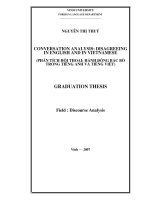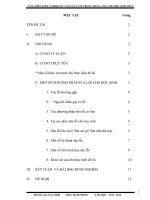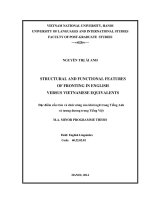Apologies in vietnamese and english=lời xin lỗi trong tiếng việt và tiếng anh
Bạn đang xem bản rút gọn của tài liệu. Xem và tải ngay bản đầy đủ của tài liệu tại đây (317.24 KB, 66 trang )
VINH UNIVERSITY
DEPARTMENT OF FOREIGN LANGUAGES
==== ====
TRẦN THỊ LONG
APOLOGIES IN VIETNAMESE AND ENGLISH
(LỜI XIN LỖI TRONG TIẾNG VIỆT VÀ TIẾNG ANH)
GRADUATION THESIS
FIELD: LINGUISTICS
VINH, 2010
2
VINH UNIVERSITY
DEPARTMENT OF FOREIGN LANGUAGES
==== ====
APOLOGIES IN VIETNAMESE AND ENGLISH
(LỜI XIN LỖI TRONG TIẾNG VIỆT VÀ TIẾNG ANH)
GRADUATION THESIS
FIELD: LINGUISTICS
Student:
TRẦN THỊ LONG
Supervisor: NGUYỄN THỊ TƯỜNG, M.A.
VINH, 2010
4
ACKNOWLEDGEMENTS
For the completion of this work, I have been fortunate to receive many
invaluable contributions from many people.
First of all, I should like to express my deepest gratitude to my supervisor,
M.A, Nguyen Thi Tuong for her detailed instructions and valuable critical
comments, without which the work would not have been completed.
In addition, I am greatly indebted to my lecturers at the Department of
Foreign Languages for their constant support and encouragement.
My sincere thanks are due to my friends for their various kinds of helps and
encouragement, especially to Thao who helped me find useful books.
I also would like to give my warmest thanks to my loving parents who have
comforted and taken great care of me to help me finish my study.
Finally, due to the limited time to complete this work, it is unavoidable to
have mistakes; therefore I am solely responsible for them and would like to
have comments from others who concern to my study.
Vinh, May 10th 2009
Tran Thi Long
i
ABSTRACT
This paper investigates the apology strategies of Vietnamese speakers
(English major students at Vinh university) based on the framework of Crosscultural Speech Act Realization project (Bulum-Kulka, S., House, J. &
Kasper, G., 1989). It attempts to discover some of the most distinctive
features of apology behavior in Vietnamese in terms of strategies and the
socio-pragmatic variables that influence the selection of apology strategies.
Based on the findings of the investigation and the research made by the group
of scholars involved in the Cross-cultural Speech Act Realization Project, the
paper also compares the apology behavior of Vietnamese native speakers and
English native speakers. Some similarities also distinctive differences were
found. The author tries to account for the differences from the perspective of
social norm, culture values and culture context. In addition, the author also
tries to give some suggested activities to help students of English improve
pragmatic awareness in making English apologies.
ii
TABLE OF CONTENTS
Page
ACKNOWLEDGEMENT...............................................................................i
ABSTRACT.....................................................................................................ii
TABLE OF CONTENTS...............................................................................iii
ABBREVIATIONS.........................................................................................v
LIST OF TABLES AND FIGURES.............................................................vi
PART A: INTRODUCTION..........................................................................1
1. Justification of the study................................................................................1
2. Aims of the study...........................................................................................1
3. Scope of the study.........................................................................................2
4. Methods of the study.....................................................................................2
5. Design of the study........................................................................................2
PART B: DEVELOPMENT...........................................................................4
CHAPTER 1: THEORETICAL BACKGROUND......................................4
1.1. Functions of Language..........................................................................4
1.2. Conversation..........................................................................................6
1.2.1. Context..........................................................................................6
1.2.2. Adjacency Pairs and Exchanges....................................................6
1.2.3. Turn – taking.................................................................................7
1.3. Speech Acts...........................................................................................7
1.4. Politeness and Strategies of Politeness..................................................9
1.4.1. Politeness and Face.......................................................................9
1.4.2. Strategies of Politeness...............................................................10
CHAPTER 2: THE SPEECH ACT OF APOLOGIZING.........................13
2.1. The Speech Act of Apologizing..........................................................13
2.1.1. Definitions of Apologies.............................................................14
iii
2.1.2. The Speech Act of Apologizing..................................................15
2.1.3. Apology Strategies......................................................................16
2.2. Factors Affecting the Choice of Apology Strategies..........................20
CHAPTER 3: THE SURVEY, RESULTS, FINDINGS, DISCUSSION
AND IMPLICATIONS.................................................................................21
3.1. The Objectives of the study.................................................................21
3.2. The Hypothesis of the study................................................................21
3.3. The Data collection instruments..........................................................21
3.4. The Participants of the study...............................................................22
3.5. The Measurement................................................................................23
3.6. The Cross-cultural Speech Act realization Project..............................24
3.7. Data Analysis, Findings, Discussion and Implications.......................24
3.7.1. Data Analysis, Findings and discussion......................................24
3.7.1.1. Apology in Vietnamese.......................................................24
3.7.1.2.
Comparison
of
Apology
Strategy
Preferences
of
Vietnamese and English speakers...................................................................33
3.7.1.2.1. Similarities...............................................................34
3.7.1.2.2. Differences...............................................................34
3.7.2. General Remarks.........................................................................38
3.7.3. Implications................................................................................ 41
3.7.3.1. To the English – major Students.................................41
3.7.3.2. Suggested Pragmatic Awareness – raising Activities 41
PART C: CONCLUSION.............................................................................45
1. Recapitulation.........................................................................................45
2. Suggestions for Further Research..........................................................47
REFERENCES
APPENDIXES
iv
ABBREVIATIONS
CCSARP
:Cross – cultural Speech Act Realization Project
DCT
: Discourse Completion Test
e.g.
: for example
et. al.
: and others
explan.
: explanation
forb.
: forbearance
FTA
: face – threatening act
H
: hearer
i.e.
: that is to say
IFID
: Illocutionary Force Indicating Device
intensif.
: intensification
minim.
: minimization
resp.
: responsibility
S
: speaker
v
LIST OF TABLES AND FIGURES
Table
Page
Table 1: Percentage of participants choosing strategies by situations in
Vietnamese.......................................................................................................
Table 2: Percentage of strategy selection from the total number of
possibilities in Vietnamese..............................................................................
Table 3: Percentage of the use of IFID in the subgroups of student
respondents......................................................................................................
Table 4: Socio – pragmatic factors by situations.............................................
Table 5: Percentage of the use of IFID and social distance indicator in each
situation............................................................................................................
Table 6: Percentage of the use of intensification and the severity indicator
in each situation...............................................................................................
Table 7: Frequency of apology in terms of social relationships......................
Table 8: Percentage of strategy selection from total number of possibilities
in Vietnamese and English...............................................................................
Table 9: The distribution of the strategy of IFID response percentage in
Vietnamese and English...................................................................................
Table 10: The distribution of the strategy of responsibility response
percentage in Vietnamese and English............................................................
Figure 1: The use of IFID in Vietnamese and English....................................
Figure 2: The use of expression of responsibility in Vietnamese and English......
vi
PART A: INTRODUCTION
1. Justification of the study
Many recent researchs (Takahashi and Beebe, 1993, Blum-Kulka and
House, 1989, Leech, 1983; Thomas, 1983) pointed out that linguistic and
lexical knowledge is not enough to be competent in using a foreign language.
Both pragmatic and socio – pragmatic considerations come into play and
constitute the important features of using a language effectively and of
achieving mutual intelligibility. According to Gumperz (1982), people in
different cultures have different ways of communication and the cultural
differences can build up to the failure in communication.
Apology, as other speech acts, reflects the cultural distinctions among
nations. Although in all languages the central function of apologies is to
provide a remedy for an offence and restore social equilibrium or harmony,
the ways of making apologies are not the same in every language. Thus,
applying the conventional usage of a language to another language (as the
learners of foreign languages often do) will cause them many difficulties and
misunderstanding in the target language. Finding the similarities and
differences in making apology between Vietnamese and English will help
Vietnamese learners more success in communication with English native
speakers.
These are the reasons why the author decided to go into this subject
“Apologies in Vietnamese and English”.
2. Aims of the study
The aims of this study are:
-
To seek the general pattern of apology verbal behaviour in
Vietnamese.
1
- To compare apology strategy preferences of Vietnamese speakers
and English speakers.
- To provide some recommendations for improving the pragmatic
awareness of Vietnamese learners in making apology in English.
The research questions of the study are:
1. What apology strategies are often used by Vietnamese speakers in
the given situations?
2. How the socio – pragmatic factors affect the strategy selection of
Vietnamese speakers?
3. What are the similarities and differences of strategy selection
between Vietnamese and English speakers?
4. What implications can be drawn in order to help Vietnamese
learners of English improve their pragmatic awareness in making
English apology?
3. Scope of the study
This study focuses on the selection preference of apology strategy of
Vietnamese speakers, the socio – pragmatic factors such as social distance,
social power, severity of offence and obligation which affect the choice of
strategy. Moreover, the study puts an emphasis on the comparison of apology
strategy preference in Vietnamese and English.
4. Methods of the study
- Revision of the theoretical publications
- Quantitative method
- Analysis and synthesis of collected data
5. Design of the study
The thesis comprises of three main parts:
2
Part A: Introduction
This part presents the justification, aims, scope, methods and
design of the study.
Part B: Development
This part is divided into three chapters:
Chapter 1: Theoretical background
Chapter 2: The speech acts of apologizing
Chapter 3: The survey, results, findings, discussion and
implications
Part C: Conclusion
3
PART B: DEVELOPMENT
CHAPTER 1: THEORETICAL BACKGROUND
1.1. Functions of Language
To know about the functions of language, we should answer the
question “what is language” firstly. However, it is complicated to define what
language is. The question “what is language”, as some would say, is hardly
less profound than “what is life” (John Lyons, 1981: 2). In everyday talk, we
use the word “language” in many different ways with its reference such as
“sign language”, “body language” or “the language of the bees”. According to
Lyons, “what is language” does not coincide with “what is a language”. The
concept of language carries with it many of the ambiguity. Let us look at
some definitions of language.
Sapir (cited in John Lyons, 1981: 3) stated: “Language is a purely
human and non-instinctive method of communication ideas, emotions, and
desires by means of voluntarily produced symbols”. In this definition, it
seems clear that there is much that is communicated by language which is not
covered by any of “idea”, “emotion” and “desire”. Besides, Howard Jackson
and Peter Stockwell (1996: 2) described language as “the human faculty that
enables us to exchange meaningful messages with our fellow human beings
by means of discourse and text, which are structured according to the rules
and conventions of the particular language that we share with them.”
Furthermore, Gary Grossgrain (1995) believed that language shapes our
conception of reality. It is clearly seen that these definitions of “language”
have served to introduce some of the properties which are essential features of
languages as we know them. Most of them take the view that languages are
system of symbols designed for the purpose of communication. Besides
4
communication, there are other purposes of language, or we might call
functions of language.
Richards (1992:150) divided language into three main functions. The
first is “desciptive” function which conveys factual information. The second
is “expressive” function which shows the speaker’s feeling, preferences,
prejudices and past experience. The last is “social” function which serves to
establish and maintain social relationship between people.
Halliday (1970:151) also divided language into three main functions
but different terms. The first is “ideational” function which refers to the
speaker’s experience of the real world. The second is “interpersonal” function
which indicates, establishes or maintains social relationship between people.
The third is “textual” function which creates written or spoken texts which fit
the particular situation.
Perhaps, the most popular divisions of language function come from
Brown and Yule. These are the transactional function, which is primarly
concerned with the transfer of information, and the interactional function, in
which the primary purpose of speech is the maintenance of social
relationships. Brown and Yule also noted that when spoken language is used
for a primarily transactional function, the purpose of the speaker in speaking
is primarily to communicate his message rather than to be nice to the listener.
They observe: “We could say that primarily interactional language is
primarily listener-oriented, whereas primarily transactional language is
primarily message-oriented” (Brown & Yule, 1983: 13).
In short, language is used to convey meaning, communicate, establish
and maintain social relations between people in everyday life. In terms of
spoken language, conversation plays a very important role because it is the
place where language is used and expressed.
5
1.2. Conversation
1.2.1. Context
To understand a conversation, context plays a very important role.
According to David Nunan (cited in Nguyen Thi Van Lam & Ngo Dinh
Phuong, 2009), there are two types of context: linguistic and non – linguistic.
The linguistic context is the language that surrounds or accompanies
the piece of discourse under analysis.
The non – linguistic context or experiential context is which the
discourse takes place within includes the type of communicative event (for
example, joke, story, lecture, greeting, conversation); the topic; the purpose of
the event; the setting, including location, time of day, season of year and
physical aspects of the situation (for example, size of room, arrangement of
furniture); the participants and the relationships between them; and the
background knowledge and assumptions underlying the communicative
event.
1.2.2. Adjacency Pairs and Exchanges
A conversation involves at least two persons, thus there are many
almost automatic patterns in the structure of conversation as following:
• Greeting – Greeting
• Congratulation – Thanks
• Apology – Acceptance
• Inform – Acknowledgement
• Leave-taking – leave-taking
According to George Yule (1996: 77), these automatic sequences are
called adjacency pairs. They always consist of a first part and a second part,
produced by different speakers. The utterance of a first part immediately
creates an expectation of the utterance of a second part of the same pair.
6
Failure to produce the second part in response will be treated as a significant
absence and hence meaningful.
Obviously, an adjacency pair is a unit of conversation that contains an
exchange of one turn each by two speakers. The turns are functionally related
to each other in such a fashion that the first turn requires a certain type or
range of types of second turn like the patterns above.
1.2.3. Turn – taking
People take turns when they are selected or nominated by the current
speaker, or if no one is selected, they may speak of their own accord (self –
selection). If neither of these conditions applies, the speaker who is currently
talking may continue.
Another feature of turn – taking is the way speakers predict one
another’s utterances and often complete them for them, or overlap with them
as they complete.
The example below is a conversation between two persons and includes
three turns.
Maria: What did you do at the weekend?
Fumiko: I went to Wales.
Maria: Oh, really? Where did you go?
(cited in Nguyen Thi Van Lam & Ngo Dinh Phuong, 2009: 63)
1.3. Speech Acts
When we speak, it also means we are taking an action which is
different from others because we use language to produce it. According to
Austin (1962) and Searle (1969), many utterances are not just used to inform
or describe something but they are used to do something, to perform action.
“Actions performed via utterances are generally called speech acts” (George
Yule, 1996: 47). They are commonly given more specific label such as
7
apology, complaint, compliment, invitation, promise, or request. Actually,
speech acts are the function aim of an utterance.
Austin (1962) pointed out that an utterance is perceived as having three
basic senses and that in performing a certain act; the speaker is performing
simultaneously three kinds of acts:
a. Locutionary act: the utterance of a sentence with determinate
sense and reference
b. Illocutionary act: the making of a statement, offer, promise, etc.
in uttering a sentence, by virtue of a conventional force
associated with it
c. Perlocutionary act: the effect of an utterance used to perform a
speech act
(Austin, 1962, cited from Levinson, 1983: 236)
According to Austin (1962), the illocutionary force is made explicit
when an utterance contains a performative verb such as apologize, invite,
order, declare, promise, etc. and such utterance is called performative
utterance. However, it might be impossible to list out all of the performative
verbs as well as all of the illocutionary acts. Searle (1969) classified
illocutionary acts or speech acts into 5 categories as following:
i. Representatives
ii. Directives
iii. Commissives
iv. Expressives
v. Declaration
8
1.4. Politeness and Strategies of Politeness
1.4.1. Politeness and Face
In conversation, besides cooperation, most interactions are governed by
politeness, which is considered a “polite social behaviour” within a certain
culture. Perhaps the most thorough treatment of the concept of politeness is
that of Penelope Brown and Stephen Levinson, which was first published in
1978 and then reissued, with a long introduction, in 1987. In their model,
politeness is defined as redressive action taken to counter-balance the
disruptive effect of face-threatening acts.
In their theory, communication is seen as potentially dangerous and
antagonistic. The basic notion of their model is “face”. This is defined as “the
public self-image that every member of society wants to claim for himself”
(1978: 66). In their framework, face consists of two related aspects: positive
face and negative face.
- Positive face is the positive consistent self-image that people have or
the need to be connected, to belong to a group.
- Negative face is the need to be independent, not imposed on by
others.
The rational actions people take to preserve both kinds of face, for
themselves and the people they interact with, add up to politeness. Thus,
showing solidarity with another is positive politeness and the awareness of
another’s right not to be imposed on is negative politeness. Brown and
Levinson also argued that in human communication, either spoken or written,
people tend to maintain one another's face continuously. When an act of
verbal or non – verbal communication “run(s) contrary to the face wants of
the addressee and/or the speaker” (Brown & Levinson, 1978: 70), this is
called a “face – threatening act” (FTA).
9
1.4.2. Strategies of Politeness
Politeness strategies are developed for the main purpose of dealing with
these FTAs. Brown and Levinson sum up human politeness behaviour in five
strategies which are given in the chart below (the higher the number of the
strategy, the more polite it is).
1. without redressive action, baldly
on record
2. positive politeness
with redressive action
Do the FTA
3. negative politeness
4. off record
5. Don’t do the FTA
The first distinction that should be made here is doing an FTA on
record (strategy 1, 2, 3) and doing it off record (strategy 4). The term “on
record” is used when an expression has “one unambiguously attributable
intention with which witnesses would occur”; on the other hand, the term “off
record” is used when an expression can have “more than one unambiguously
attributable intention” (Brown & Levinson, 1978: 73 – 74). For example, if
person A wanted to borrow person B’s car and said, “May I borrow your car,
tomorrow?” she would be going on record because the request to borrow B’
car is unambiguous; however if she said, “I need to pick up my friend at the
airport tomorrow, but I don’t have a car”, she would be going off record
because there is no explicit request.
Strategy 1 – doing an act baldly, without redressive action or bald on
record “involves doing it in the most direct, clear, unambiguous and concise
way possible” (Brown & Levinson, 1978: 74). For example, person A in the
10
above example might say, “Lend me your car, tomorrow” to do the FTA
baldly.
Strategies 2 and 3 – doing an act with redressive action means “‘giving
face’ to the addressee” (Brown & Levinson, 1978: 74). This can mean doing
the act using positive politeness (strategy 2) – “oriented towards the positive
face of the hearer” or using negative politeness (strategy 3) – “oriented
mainly toward partially satisfying (redressing) hearer’s negative face” (Brown
& Levinson, 1978: 75). For example:
- Positive politeness strategy: “Hey, that’s a great suit you have on! Is it
new? (…) By the way, may I borrow your car, tomorrow?” (adapted from
Brown & Levinson, 1978: 108)
By asking about the hearer’s suit, the speaker would show that she is
interested in something that the hearer presumably finds desirable, for
example, the suit.
- Negative politeness strategy: “You couldn’t by any chance lend your
car, tomorrow, could you?” (adapted from Brown & Levinson, 1978: 141)
In this case, the speaker is trying to partially satisfy the hearer’s desire
not to be imposed upon by implying that she does not think he can lend her
the car.
It is not justifiable, however, to always choose the most polite strategy,
because “that will imply that the act is more face threatening than it actually
is” (Fasold, 1990: 162); therefore, the speaker must decide which strategy to
use. This decision is based on the following three factors (Brown & Levinson
1987: 79):
1. The “social distance” of the speaker and the hearer (a symmetric
relation) (For example, with a friend there is not a great social
distance; however there is with a stranger.)
11
2. The relative power of the speaker and the hearer (an asymmetric
relation) (For example, a friend does not hold the same position of
power as does the President)
3. The absolute ranking of impositions in the particular culture (For
example, asking someone to borrow a quarter would be as great an
imposition as asking that person to borrow one hundred dollars)
Another politeness principle is proposed by Geoffrey Leech (1983),
which explains how politeness operates in conversational exchanges. Leech’s
principle, also called Leech’s maxims, includes six maxims.
- Tact maxim (in directives [or impositives] and commissives):
minimize cost to other; [maximize benefit to other]
- Generosity maxim (in directives and commissives): minimize benefit
to self; [maximize cost to self]
- Approbation maxim (in expressives and representatives [assertives]):
minimize dispraise of other; [maximize praise of other]
- Modesty maxim (in expressives and representatives): minimize praise
of self; [maximize dispraise of self]
- Agreement maxim (in representatives): minimize disagreement
between self and other; [maximize agreement between self and other]
- Sympathy maxim (in representatives): minimize antipathy between
self and other; [maximize sympathy between self and other]
12
CHAPTER 2: THE SPEECH ACT OF APOLOGIZING
2.1. The Speech Act of Apologizing
2.1.1. Definitions of Apologies
Apologies are one of the many speech acts frequently used in human
interaction. There are numerous studies providing definitions of an apology as
well as examining its functions.
“Apologies are defined as primarily social acts, carrying effective
meaning” (Holmes, 1990: 1550). According to Brown and Levinson,
apologies are politeness strategies. An apology is primarily and essentially a
social act. It is aimed at maintaining good relation between participants. To
apologize is to act politely, both in vernacular sense and in more technical
sense of paying attention to the addressee’s face needs (Brown & Levinson,
1987). An apology is a fundamental speech act which is a part of human
communication occurs in every culture to maintain good relations between
interlocutors.
Goffman (1967: 14) referred to an apology as a remedy, the one
essential element in a remedial interchange. This term nicely highlights the
central function of apologies to provide a remedy for an offense and restore
social equilibrium or harmony (Edmondson 1981: 280, Leech, 1983: 25)
(cited in Holmes, 1990: 159). Apologies, like compliments, are primarily
aimed at maintaining on supporting the addressee’s and in some cases the
apologizer’s “face” (Goffman, 1967).
According to Olshtain and Cohen (1983: 20), “an apology is called for
when social norms have been violated, whether the offence is real or
potential”. In addition, Aijmer (1996: 81) argued that what seems to be
necessary is that the “apologizer” has done something which is annoying or
13
damaging to the person to whom the apology is addressed. The apologizer
now regrets having done the act and takes responsibility for it by uttering an
apology.
As Blum-Kulka, House, and Kasper (1989: 12) described, an apology
is the acknowledgement by the speaker that a violation has been committed
and an admission that he or she is at least partially involved in its cause. An
apology may be considered a “post-event,” for it signals that the event has
already taken place.
These definitions indicate that the intention of the apologizer is to
produce an utterance in order to redress the offence. The functions of an
apology have also been examined in studies to gain understanding of further
functional aspects of the speech acts.
The social functions of apologies have been described as follows by
Norrick (1978: 280):
- Admitting responsibility for a state which affected someone in an
adverse way (thereby implicating contrition)
- Asking to be forgiven
- Showing good manners
- Assuaging addressee’s wrath
- Getting off the hook
Normally, apologies relate to past acts, since we can not apologize for
something we have not yet done. However, just as it is possible to thank
somebody in advance, it is also possible to apologize for future offence.
“Apologies, which occur prior to the offence can be justified on the grounds
that it is possible for the speaker to apologize for something he or she is in the
course of doing, or has not yet done, provided that both speaker and hearer
have good grounds to believe that it will be done” (Owen, 1983: 117). In this
14
study, we concentrate on apologies as remedial responses to offending acts,
and the occurrence of apologies as described above is not subjected to
investigation.
2.1.2. The Speech Act of Apologizing
Olshtain (1989: 156) defined apology as “a speech act which is
intended to provide support for the H (hearer) who was actually or potentially
malaffected by violation X. In the decision to carry out the verbal apology,
the S (speaker) is willing to humiliate himself or herself to some extent and to
admit to fault and responsibility for X. Hence the act of apologizing is facesaving for the H and face-threatening for the S, in Brown and Levinson’s
(1978) terms”. According to Leech’s (1983: 104) “tact maxim”, apology is a
convivial speech act whose goal coincides with the social goal of maintaining
harmony between the speaker and the hearer. In Leech’s term, therefore, the
realization of an apology provides benefit for the hearer and is to some degree
at cost to the hearer.
Apologies fall under expressive speech acts in which speakers attempt
to indicate their state or attitude. In order for an apology to have an effect, it
should reflect true feelings. “One cannot effectively apologize to another and
truly reach him or her unless one portrays honest feelings of sorrow and regret
for whatever one has done” (Fahmi, Ruba & Fahmi, Rula, 2006: 1903).
Apologies are like other speech acts in that they are often performed
through conventionalized or ritualized utterances. According to Hudson
(1980: 52) conventionalizing any linguistic pattern is a matter of historical
accident. Once expressions are selected in preference to others to be used to
perform certain acts, it becomes a necessity that they are used and interpreted
as such certain forms which are more conventional used more often than
15









